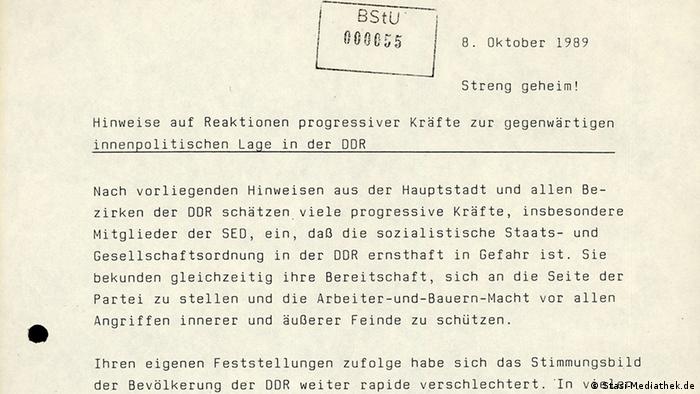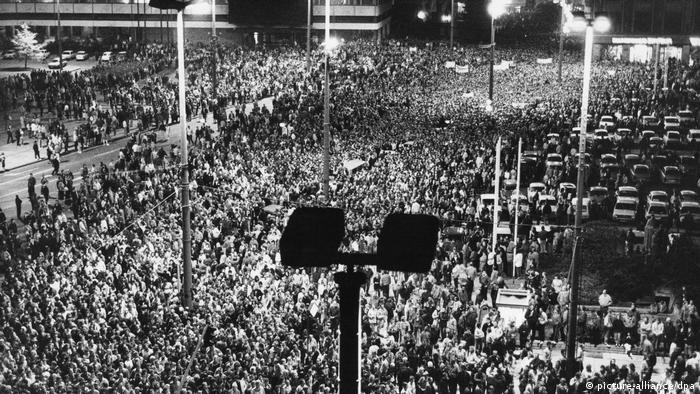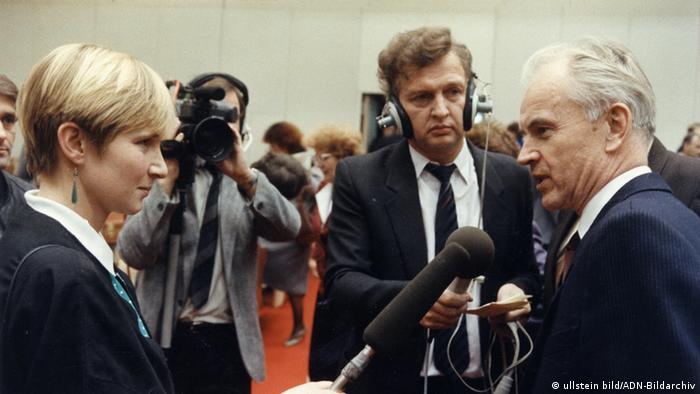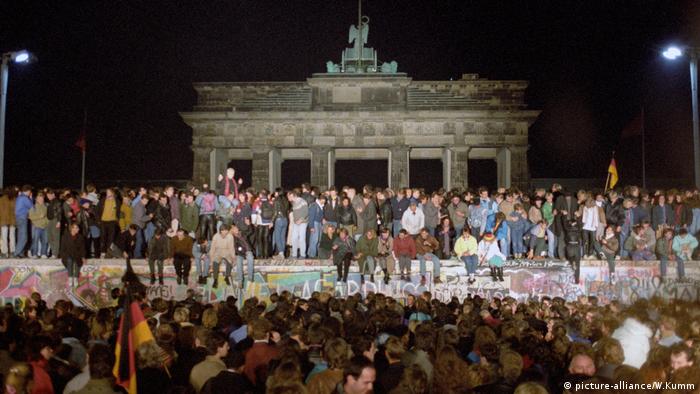The Ministry for state security documented over decades, the conditions in their own country. His reports give an idea of why the SED-dictatorship in 1989, slipped away, and in the end, the Berlin wall fell.

“Top secret!” is on the slightly yellowed sheet of paper from the 8. October 1989 on the “current political situation in the GDR”. The day before, had celebrated the Communist Regime with state and party chief Erich Honecker at the top himself: 40 years of the German democratic Republic (GDR). But that’s not the point in the seven-page report of the Ministry for state security (MfS), short Stasi. On the contrary, It is feared, “that the socialist state and social order in the DDR is seriously in danger”.
How justified your concern is, shows up a month later On 9. November, the Berlin wall falls. The end of the GDR, is now only a matter of time; not a year of unification on 3 passes to. October 1990. At this time, the Stasi is history. It releases pressure from civil rights to learning during the peaceful Revolution itself. Irony of history: notes on the Exitus in the secret Reports to the SED (Socialist unity party of Germany), which are now available under the book title “The GDR in the eyes of the Stasi” for the year 1989.
In Leipzig, the Stasi’s district office, “unable to act”
In the “Information no 519/89” from the 5. December 1989 is described in detail, such as about 50 members of the opposition in the Leipzig Stasi district office to penetrate. Therefore, keep the object “to its neuralgic points” to be occupied. The result: “The district office is unable to act.” The driving forces are groups with a programmatic name: Initiative for peace and human rights (IFM), New Forum (NF), Democratic awakening (DA). Names that appear in the autumn of 1989, in the Stasi Reports of more and more.

Makes lots Stasi: In October 1989, over 100,000 people took part in Leipzig at the Monday demonstrations
The protagonists are described in typical Stasi Jargon. It was “almost exclusively known reactionary Church officials, and other enemy, the opposition forces”. People like Peter Grimm, IFM co-founder and editor of the underground newspaper “the limiting case”. A key experience for the then 24-Year-olds, the reaction of the GDR on the brutal suppression of the democracy movement in China: The authorities in East Berlin show solidarity ostentatiously with the Communists in Beijing.
Hans Modrow holt GDR civil rights activists in the government
“It is an escalation was foreseeable,” says Grimm, 30 years later. “Those who behave irrationally, is not predictable.” The fear of a similar reaction in the beleaguered East German regime against its own population is in 1989, frighteningly real. The suspect also probably the for the district of Dresden, the responsible SED-politician Hans Modrow. In West Germany, he is considered to be bearers of hope. A, could trigger, according to the model of the former Kremlin chief Mikhail Gorbachev’s democratic reforms in the GDR.

13. November 1989, Hans Modrow (r.) is elected by the GDR people’s chamber of the GDR Prime Minister
And in fact, it is Modrow, the head takes four days after the fall of the wall in Berlin, as a new government, a new course. Civil rights activists are pushing him to the so-called round table to be appointed in February 1990, members of the opposition in his Cabinet. Modrows attempt to save the Stasi under the name of “National security” (East German people’s chamber) in the new time, it fails.
Not a single word about the fall of the Berlin wall
The 40 years of exalted service, can be rolled over at the end of so much of the events that you a single word about the epochal opening of the border on 9. November logged. The historian Daniela Münkel puzzled still today about the reason for this astonishing gap in the otherwise usual pedantic-run Stasi Reports of the year 1989. A possible explanation for the fall of The wall was shown worldwide on live television. “What you want yet?” the editor of the current volume of the books series says “The GDR in the eyes of the Stasi”.

Berlin, on the night of the fall of the Berlin wall at the Brandenburg gate, the Stasi in their Reports, no note
In November 1989, the Stasi was busy only with their own survival, says Daniela Münkel. This futile Effort is also reflected in the Reports of the Ministry for state security. When the wall is already five days, the Stasi, in a report on the “current situation” even in-house advertising:
“In many discussions, the staff of the MfS to bring your will and your willingness to support the course of the turn and actively help in the restoration of the relationship of Trust between the party and the people.”
It’s already much too late. The turning point is irreversible. The conclusion of the historian Daniela Münkel: “In the first half of 1989, the Stasi still in charge.” The changes, as from the GDR Opposition a mass movement. Trying to save what can still be saved. And at the end of the MfS is to be the “chronicler of his own decline”.